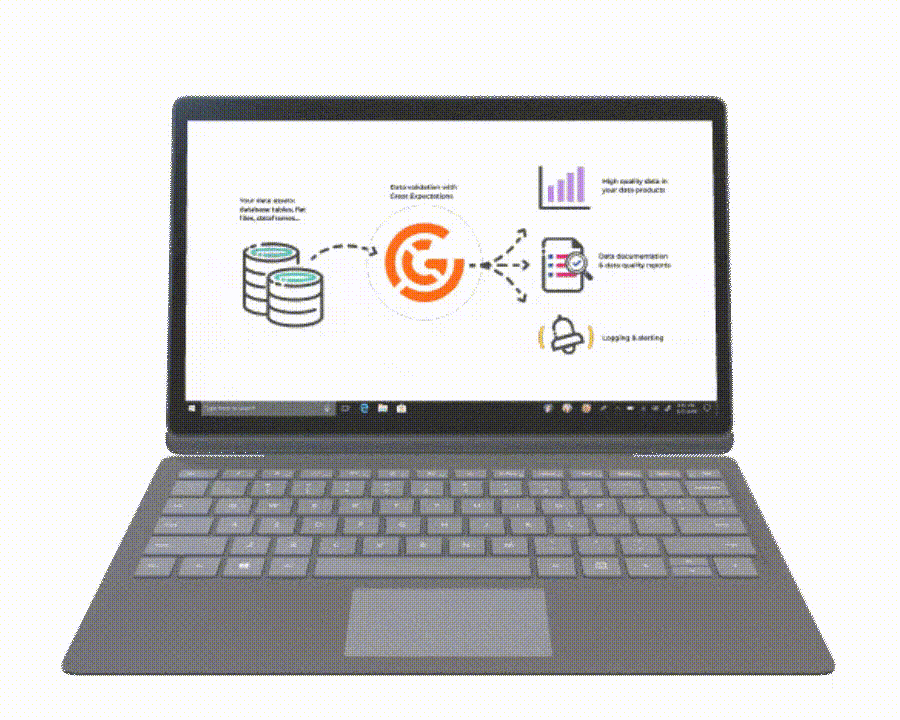Explore the landscape of data quality management in today's data-driven world. Learn about data quality testing, data monitoring, and data observability.
In today's fast-paced data-driven world, the significance of data quality management cannot be overstated.
The explosion of data and the increasing reliance on artificial intelligence in enterprises have made ensuring data quality a critical priority for modern businesses. This post delves into the core aspects of data quality management, including data quality testing, data quality monitoring, data observability, and the broader data estate. We'll explore how these components interact and why they are essential for maintaining data integrity and trust in 2024 and beyond.

Data Quality Framework
Automate your data quality management with Bismart Data Quality Framework – a tool that validates, documents, and profiles your data for optimal quality.
The Modern Data Quality Challenge
Imagine you're in charge of a city's water supply.
Initially, with a population of 1,000, managing the water system is relatively straightforward. However, when the population suddenly swells to 1,000,000, the complexity skyrockets.
The same principle applies to data management. As data volumes grow, traditional methods of ensuring data quality become increasingly inadequate.
The rapid expansion of data environments necessitates more sophisticated approaches to data quality management.
Simple methods like manual checks and basic automated tests no longer suffice. Instead, we need comprehensive solutions that can scale with the complexity and volume of modern data estates.
Understanding Data Quality Testing
Data quality testing is one of the foundational approaches to managing data quality. It involves creating user-defined rules or constraints to identify specific known issues within a dataset. This method helps validate data integrity and ensure that data meets predetermined quality standards.
While effective for smaller data environments, data quality testing has its limitations:
- Specialized Knowledge Required: It demands a deep understanding of the data and potential issues.
- Limited Coverage: It can only identify issues that have been specifically anticipated and coded into tests.
- Scalability Issues: As data environments grow, the number of required tests can become unmanageable.
- Lack of Visibility: Testing focuses on data itself, not the systems or code that process it, limiting the ability to identify root causes of issues.
- No Resolution Mechanism: Testing can highlight problems but does not provide solutions or insights into their impact.
Detailed Analysis of Data Quality Testing
Delving deeper into data quality testing, it's crucial to recognize that this approach relies heavily on user-defined constraints and rules.
These rules are typically crafted by data engineers who possess intimate knowledge of the datasets they oversee. For instance, they might write scripts in SQL or use modular solutions like dbt to detect issues such as excessive null values or incorrect string patterns.
However, this method is inherently limited by its reactive nature. Data quality testing is excellent for identifying problems that you know might exist. But what about the unknown unknowns? This is where data quality testing shows its limitations.
As your data needs grow, the number of potential issues multiplies, making it challenging to keep up with the pace solely through manual or rule-based testing.
Moreover, data quality testing does not scale well. Writing ten tests for thirty tables is manageable, but scaling this to hundreds of tests across thousands of tables quickly becomes impractical.
Additionally, data testing offers limited visibility into systemic issues. It can tell you that there's a problem with the data, but not whether the issue lies with the data itself, the system generating the data, or the code processing it.
Most critically, data quality testing lacks a resolution mechanism, leaving teams to identify issues without guidance on how to fix them or whom it affects.
To overcome these limitations, automated data quality solutions like the Data Quality Framework can be employed.
What is Data Quality Framework?
Data Quality Framework centralizes all data quality processes, making them accessible at all levels within an organization. It validates, documents, and profiles data to ensure optimal quality, and it features an alert system for proactive management.
The framework allows for the creation of custom quality standards and integrates seamlessly with existing data pipelines, enhancing scalability and providing actionable insights into data issues. By automating the validation and correction processes, it ensures data consistency, integrity, and reliability, ultimately improving decision-making quality.

For more information check Data Quality Framework's website.

Data Quality Framework
Automate your data quality management with Bismart Data Quality Framework – a tool that validates, documents, and profiles your data for optimal quality.
The Role of Data Quality Monitoring
Transitioning to data quality monitoring, this method offers a broader, more continuous approach. Unlike testing, which is often a one-time or periodic activity, monitoring is an ongoing process that keeps a constant watch over data to identify anomalies as they occur.
This can be manual, involving the setting of thresholds, or automated through machine learning algorithms that learn normal data patterns and flag deviations.
Data quality monitoring excels in covering the "unknown unknowns" that testing might miss. It can alert teams to unexpected changes in data patterns, such as an unusual drop in the number of rows in a dataset or data arriving later than expected.
This continuous monitoring provides a more holistic view of data quality over time.
The benefits of data quality monitoring include broader coverage and the ability to identify unknown issues. However, it also has its drawbacks:
- High Compute Costs: Continuous monitoring requires significant computational resources.
- Slow Time-to-Value: Setting up and scaling monitoring systems can be time-consuming.
- Limited Context: Like testing, monitoring primarily looks at data and lacks insight into underlying system issues.
- Alert Fatigue: Excessive alerts without clear prioritization can overwhelm data teams and reduce overall effectiveness.
Again, to address these challenges, solutions like Data Quality Framework can be an invaluable tool. Not only to automate the monitoring process, but the solution also integrates intelligent alert management to prioritize issues, reducing alert fatigue.
By providing insights into both data and system-level issues, the framework offers a comprehensive solution that enhances the effectiveness of data quality monitoring and ensures timely, actionable responses to anomalies.
The Power of Data Observability
This brings us to data observability, a more comprehensive solution designed to overcome the limitations of both testing and monitoring.
Data observability provides end-to-end visibility into the health of your data estate, encompassing not just the data itself, but also the systems and processes that handle the data.
Data observability integrates automated data quality monitoring and testing into a unified framework. This approach leverages artificial intelligence and machine learning to automatically detect and triage issues, providing instant coverage and scalability.
It extends visibility beyond data sources to include the entire data infrastructure, from ingestion pipelines to post-ingestion systems. This comprehensive coverage helps identify root causes more quickly, enabling faster resolution of issues.
One of the standout features of data observability is its ability to track the health of specific data products or critical assets. This goes beyond traditional table-based monitoring to provide insights into the performance and reliability of key data components.
By fostering collaboration across teams, including data engineers, analysts, and stakeholders, data observability ensures that everyone has access to the same accurate, real-time information about data health.
From Data Quality Testing to Data Observability
Bismart's Data Quality Framework is a data observability solution. By centralizing monitoring, testing, and observability efforts, this framework enhances collaboration and provides comprehensive insights into data and system health.
The integration of AI-driven anomaly detection and intelligent alerting streamlines the identification and resolution of issues, ensuring data reliability and data integrity across the entire data pipeline.

Data Quality Framework Datasheet
Learn the technical capabilities of Data Quality Framework in the datasheet.
Key features of data observability include:
- Robust Incident Resolution: Automated tools for triaging and resolving issues quickly, with clear visibility into the affected data and impacted stakeholders.
- Complete Visibility: Extends beyond data sources to include infrastructure and post-ingestion systems, providing a holistic view of data health.
- Faster Time-to-Value: Machine learning-based monitors and automated setups offer immediate coverage and scalability.
- Data Product Health Tracking: Monitors the health of specific data products or critical assets, ensuring their reliability.
The Future of Data Quality in the AI Era
As we move further into the age of AI, the stakes for data quality management are higher than ever, as poor data quality can lead to inaccurate AI outputs, undermining the trust and value of AI-driven insights.
Traditional methods alone are insufficient to meet these challenges, making data observability crucial for ensuring data quality in complex, AI-driven environments.
Data observability stands out by combining the strengths of testing and monitoring with advanced visibility and resolution capabilities, enabling data teams to maintain data integrity at scale. The importance of data observability becomes even more pronounced in the context of AI, where high-quality data is essential to avoid erroneous conclusions and decisions.
The complexity and scale of AI systems demand robust data quality management practices that can keep up with rapid changes and vast volumes of data.
By automating the detection, triage, and resolution of data issues, data observability ensures that data teams can maintain the high standards of data quality required for reliable AI outputs, enhancing the accuracy of AI models and building trust in AI-driven insights across the organization.
Conclusion
In conclusion, the landscape of data quality management is evolving rapidly, driven by the increasing complexity and scale of data environments. Traditional methods like data quality testing and monitoring remain important, but they are no longer sufficient on their own. To keep pace with modern data needs, organizations must adopt more comprehensive solutions like data observability.
Data observability offers the end-to-end visibility, scalability, and actionable insights needed to ensure data quality in today's fast-paced, data-driven world. By integrating testing and monitoring into a unified framework, it provides a holistic view of data health and enables faster, more effective resolution of data issues. As we move further into the AI era, the ability to maintain high data quality will be a critical differentiator for successful organizations. Embracing data observability is not just a best practice; it is a necessity for thriving in the modern data landscape.

Data Quality Framework
Automate your data quality management with Bismart Data Quality Framework – a tool that validates, documents, and profiles your data for optimal quality.
.png)


